I threw open the drapes of my stateroom and gasped. Gone were the gray skies of Amsterdam and Cologne. Brilliant sunshine promised a perfect day of sailing through the Middle Rhine Valley, a fairy tale landscape of glittering green hillsides, where near-vertical vineyards tumbled down toward the emerald river.

Since prehistoric times, the Rhine has been one of the world’s most important trade routes, and the 40 castles and forts found in the UNESCO World Heritage area between Koblenz and Bingen are testament to how much these lands have always been coveted. The castles, mostly constructed between the 12th century and the first half of the 14th century, were built by the princes of the empire to protect their land holdings and mineral rights from political rivals. Toward the end of the 13th century, however, they seized upon an even more important source of revenue: collecting tolls from ships using the Rhine to transport goods. Chains were strung across the river and lowered only when the toll had been paid.
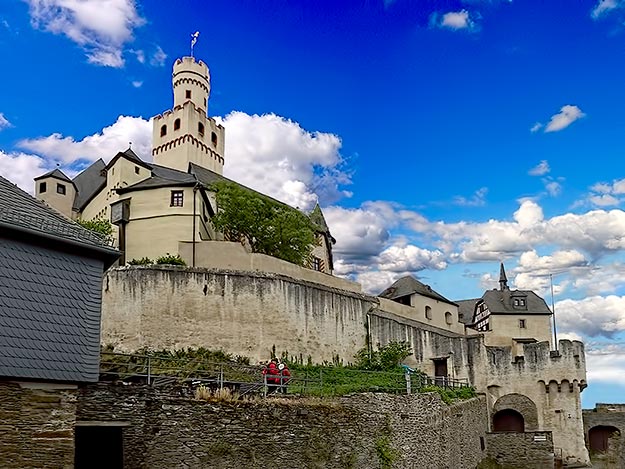
The importance of the castles of the Middle Rhine began to decline in the 14th century, but their final death knell sounded during the Thirty Years War (1618 to 1648) and the subsequent War of the Palatine Succession (1688 to 1697), when most were destroyed. Only three were spared – Ehrenbreitstein, Marksburg and Burg Rheinfels – and my day would start at Marksburg, the only one that was never conquered.
Today Marksburg remains much the same as when it was originally built. The roads leading into the bowels of the castle consist of jagged stones laid inexpertly on a steep grade that had me wondering how horses could have made the climb, especially when carrying knights in full armor. Thick stone walls and few windows kept the interior shrouded in darkness and chilly enough to make me shiver, even in the middle of summer. Any warmth would have come from enormous fireplaces that required an endless supply of firewood, all of which had to be carted from the slopes below. Even cooking a meal, which required the use of unwieldy iron kettles, would have been torture.
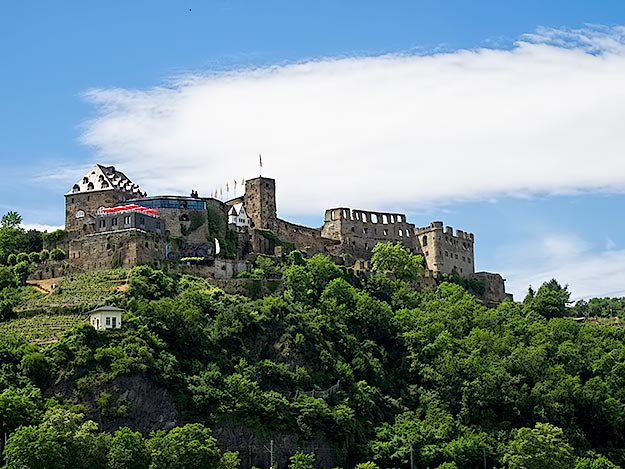
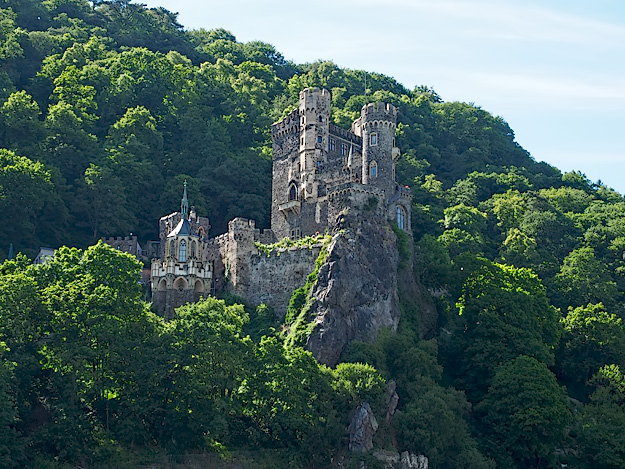
Back on the ship I climbed to the sunshine-drenched upper deck, where, for the next 40 miles, I had a birds-eye view of the castles and fortifications along the Middle Rhine. Some were monolithic, featuring crenelated ramparts and Disney-esque turrets, while others were a simple square keep. Many were just shells, their interiors disintegrated and roofs caved-in. One pair especially caught my fancy. Constructed by warring factions within sight of one another, they were dubbed Burg Maus (Mouse Castle) and Burg Katz (Cat Castle), for the cat and mouse power game their princely owners waged.

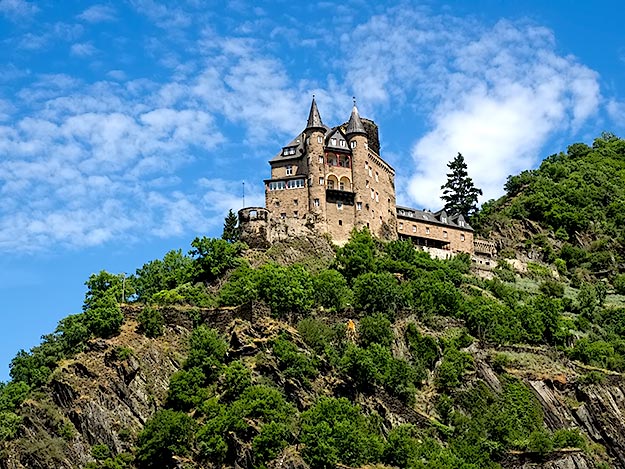
Unique among the fortifications was Pfalzgrafenstein Castle, built on an island in the middle of the river. Though more susceptible to attack, the island location gave its owner a distinct advantage in the collection of shipping tolls.
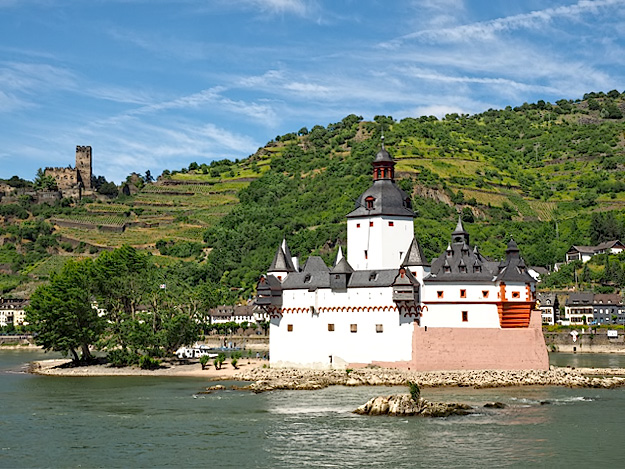
After Ehrenfels Castle, the landscape flattened out and the river widened. When Klopp Castle came into view in Bingen, the Middle Rhine became the Upper Rhine, and the castles disappeared. My romantic notions having been crushed by a close-up encounter with Marksburg, I decided that viewing castles was best done from afar – from the top deck of a cruise ship, to be precise. Even so, that night I dreamed of knights and ladies-in-waiting and castles decked in rich tapestries.
Note: I was a guest of Viking River Cruises during my Grand European Tour, however, the receipt and acceptance of complimentary items or services will never influence the content, topics, or posts in this blog. I write the truth, the whole truth, and nothing but the truth. Viking offers itineraries on the great rivers of the world, including destinations in Europe, Egypt, China, Southeast Asia, Russia, and soon, in the U.S.

I live on the Rhine near Bacharach and you have not even listed half of the castles on the 40-mile stretch of river between Bingen and Koblenz. I live near the “Siebenburgenblick”, an outlook tower where you can see seven castles from one place.
Hi Paul: I realize there are many more than what I listed, but I was on a Viking River cruise, so only discussed what I saw.
Hello,
My maiden name is Katz. Currently, I have family living in the Munich Germany area. My ancestors were farmers who lived in the Rhine valley. I’ve been to Germany 5 times. Last year I took a cruise on a Viking longboat down the Danube. I only discovered, in early 2015, that there is a Katz castle from seeing it in a subsequent Viking cruise brochure. I am wondering if I could visit, tour, stay in the Hotel Katz castle. I’ve heard it is privately owned and closed to the public, but I’ve gotten mixed messages. As a travel insider you might be privy to it’s reopening? If a Japanese business consultant bought it for 4.3 million, it seems he might sell or reopen for business one day? Any suggestions? Thank you.
Hi Deborah: It certainly would be fun to stay in a castle carrying your last name. Unfortunately, I’m afraid I can’t help you. I didn’t visit the castle, as I was on a river cruise and only got to sail past it. I guess I’d tell you to just Google it every now and then and see if things change.
Hi Barbara, great post and wonderful pictures!
I can’t agree with one thing, though – “viewing castles was best done from afar”. From the castles you mention I’ve only been to Rheinfels, but it was such a great experience! We found out there are numerous tunnels, some of them only maybe 1.20 m high and very dark, and it was probably the best castle visit we’ve had 🙂 In fact, you can read more about it here: http://ntripping.com/roller-coasters-football-and-castles/
Cheers, N.
I’ll have to look into that one, NTripping. I’m sure there are some that are more interesting than others, but I’ve now toured at least a dozen castles (just another one today) and they’re pretty monotonous and same-same.
Hi, I really enjoyed reading your blog, I feel almost as if I have taken this trip with you. The castles truly do look fairy tale worthy. I can’t help thinking there are so many adventurous and historic tales that have been lost pertaining to them, and the people who lived in them. Also, it’s amazing how well they have endured the test of time. Great pictures and writing. Thank you!
Hi Mahee: Interesting comment. I never really thought about it before, but I’m sure you’re correct that the old saying, “If these walls could talk, the tales they would tell,” is very true.
A wonderful read! I actually spent four years of my childhood living in Koblenz. Such a beautiful area. Did you know that the castle Ehrenbreitstein now has a Youth Hostel in it? So, you can stay inside the castle.
(To be honest, it wasn’t the best hostel I’ve stayed at, but the view was great!)
🙂
Hi Leigh – I had NO idea about the hostel in Ehrenbreitstein! Thanks for passing along that tidbit. I missed seeing that castle, because I had to choose between it and Markburg, and I choose the latter. Just a good excuse to return some day 🙂